Rhabarbari, Rhubarb, Da Huang 大黄Rha Barbarum, Raved Sceni, Turkey RhubarbDa Huang: ‘Big Yellow’ (TCM) Amla-Vetasa or Amla Parni (Ayurveda) Chu rtsa ལྕུམ་རྩ (Tibet) |

|

|
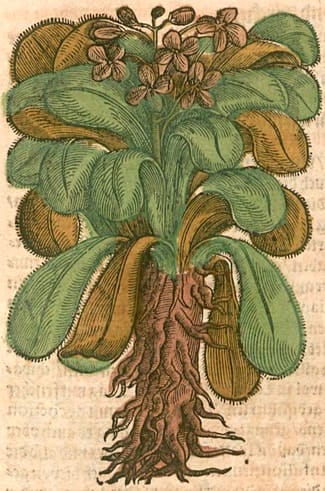 Krauterbuch, Lonitzer, 1578
Krauterbuch, Lonitzer, 1578
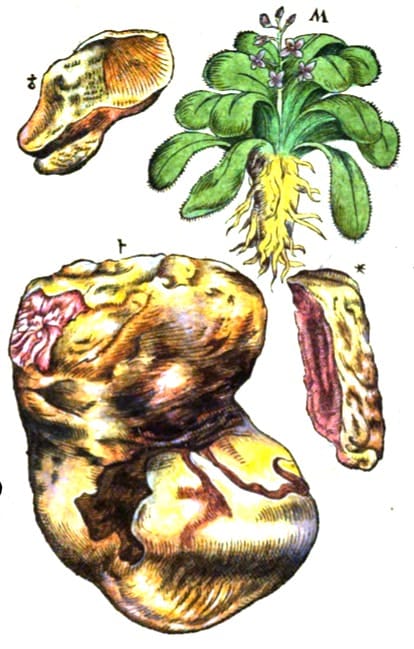
|
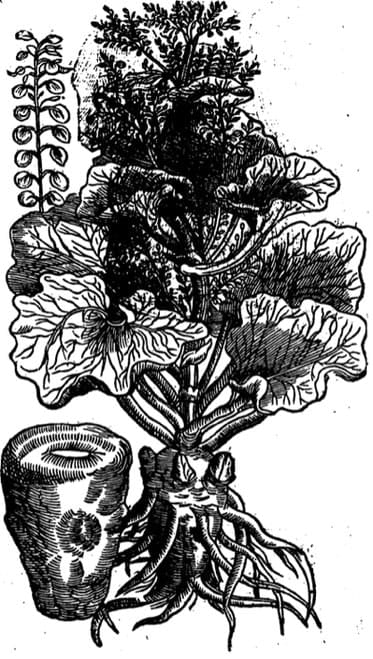
|
|
Kreutterbuch, Matthiolus, 1586 |
Parkinson, Theatrum Botanicum, 1640 |
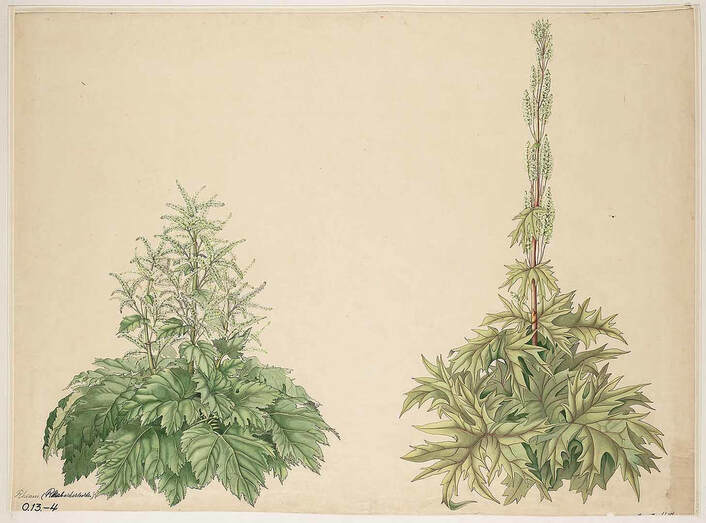 Two forms of Rhubarb
Two forms of RhubarbBotanische wandplaten, (1904–1914)
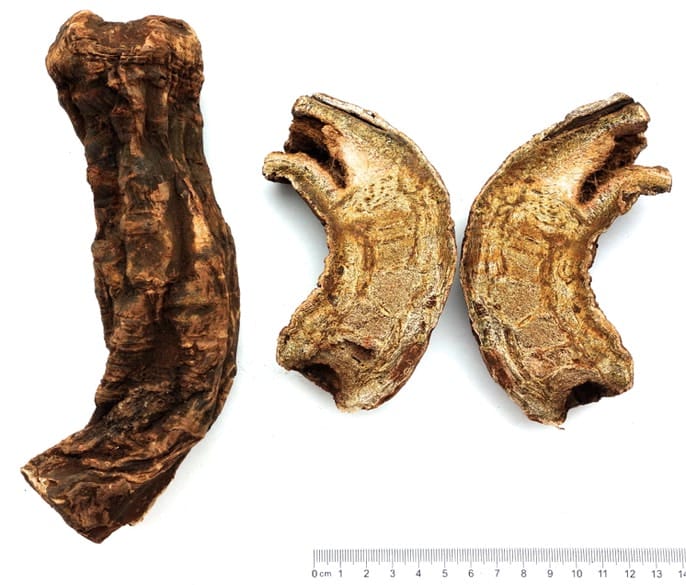 Wild-crafted Rhubarb: whole (left) and sliced (right)
Wild-crafted Rhubarb: whole (left) and sliced (right)(Chengdu, 2016, photo by Adam) |
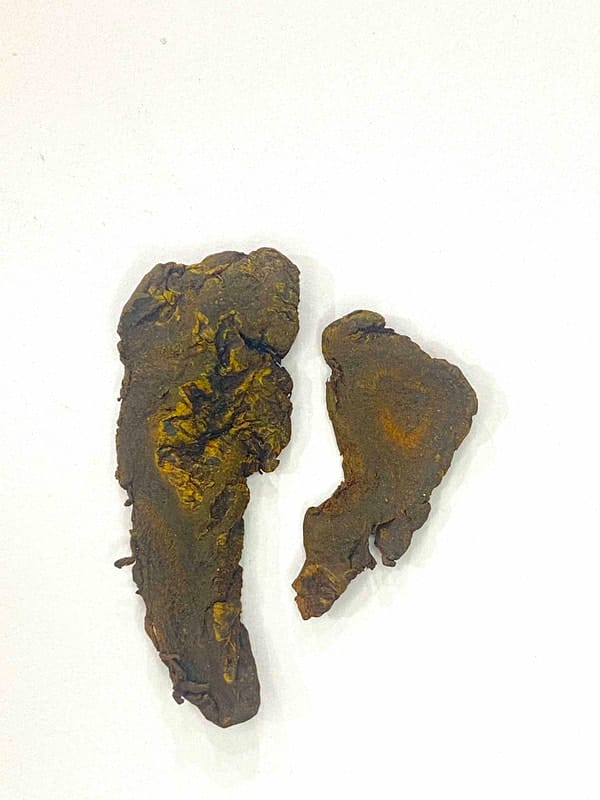 Wine prepared Rhubarb root (Shu Da Haung)
Wine prepared Rhubarb root (Shu Da Haung)(Adam, 2024) |
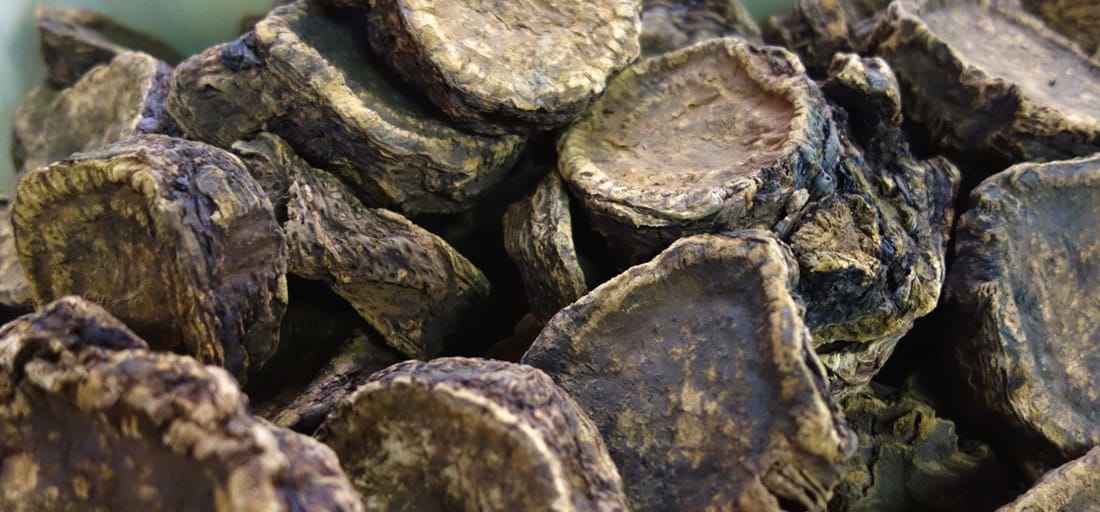 Large slices of Wild Rhubarb (Adam, 2016)
Large slices of Wild Rhubarb (Adam, 2016)Botanical name:
Rheum palmatum, R. officinale
Many species are used including R. emodi (syn R. australe), R. tanguticum, R. undulatum, R. speciforme, R. coreanum, R. moorcroftianum, R. nobile, R. webbianum
Rhubarb species are complex and varied. In general they can be divided into:
- Chinese Rhubarb: R. palmatum (regarded as best), R. officinale
- Indian Rhubarb: R. emodi, R. webbianum, R. moorcroftianum and R. spiciforme
- Himalayan Rhubarb: R. webbianum, R. spiciforme
Parts used:
Root (Rhizome)
Temperature & Taste:
Cold, dry. Bitter.
Considered Warm and dry in Western and in Unani medicine.
Classifications:
2A APERIENT. 2D ATTENUATERS OF CONGEALED BLOOD. 2F. PURIFYING 2G. CLEANSING. 2O. ASTRINGENT. 2P. HEMOSTATICS
2S. STRENGTHENING
3B. FEBRIFUGE & ANTIPYRETIC. 3M. ARTHRITIC. 3Q. ANTHELMINTIC
4a. CEPHALIC. 4e. STOMACHIC. 4g. HEPATIC
Uses:
1. Clears Heat, Purges Accumulations, Promotes Stool (TCM, West, Ayurveda, Tibetan):
–purges Bile, stagnant food, congested Blood, and Ama (toxic residues of digestion).
-heat and obstruction of the Stomach, Liver and Bowels.
-Constipation and abdominal fullness with heat symptoms
-acute Appendicitis, partial intestinal obstruction
-acute Jaundice, Gall-stones, and Sciatica associated with heat.
-Madness, Convulsions, Frenzy, Mania
2. Clears Heat and Toxin (TCM, West, Ayurveda, Tibetan):
-clears Heat and Toxin from the Stomach, Bowels, Liver and Blood
-venomous Bites
-Chronic Fever; Influenza; acute excess Heat and Toxin including Acute Sore Throat, Tonsillitis
-damage caused by excess drinking (Hübotter, Contributions to the knowledge of Chinese and Tibetan-Mongolian pharmacology, 1913)
-Arthritic disorders; some claimed long-term use of small doses to be very effective in Rheumatism
-“Beneficial in Chronic and Intermittent Fevers” (Avicenna)
-“It is also beneficial in insect bite”. (Avicenna)
3. Moves the Blood, Clears Stasis (TCM, West, Ayurveda, Tibetan):
-Blood stagnation after Trauma, Bruising, Fractures
-Amenorrhea and Dysmenorrhea
-Tumors and Cancer (inc. Breast, Bowel, Liver, Uterus, Myoma, Melanoma and Leukemia)
-“Most useful in cases of Injuries caused by Falls and Beating”. (Avicenna)
-in TCM, the wine-prepared root is used; this makes it stronger, but is not necessary to move the Blood
4. Guides Downward:
-Wind-Heat Headache, Dizziness, Vertigo, Hypertension
–Mania, Schizophrenia, Insomnia, Anger, Hyperactivity
-sensation of Qi rising in the body; excess in the upper body
5. Benefits the Stomach and Digestion:
-various old authors recommended small doses as a strengthening tonic. (Haller, Lexicon, 1755)
-small doses are used to improve digestion, resist fermentation and increase gastric acid
-Childhood Nutritional Impairment; chronic digestive weakness in infants, including that caused by Worms
6. Clears Heat, Opens the Lungs:
-Cough, Breathless, Asthma coming from Heat
-Pleurisy, inflammation of the Lungs; Spitting of Blood. (Dioscordies)
-“It is useful in Asthma and Hemoptysis”. (Avicenna)
7. Clears Heat, Stops Bleeding:
-charred Rhubarb has been used in TCM and the West to stop bleeding, especially of the gastrointestinal tract
-Hemoptysis. (Dioscordies)
-bleeding from the bowels with constipation; Dysentery with Blood
-excess Menstruation
8. Kills Worms:
-Worms in children (Matthiolus)
9. Externally:
-applied to Boils, Burns, Carbuncles, Herpes and various skin problems with heat and toxin. (wash, powder, or ointment)
-the powder mixed with vinegar was applied to Eczema, Ringworm, Bruises and Burns.
–Dioscorides said ‘it dissipates all inveterate inflammations being applied with water’.
-applied with Wine to Masses, Lumps, Swellings and Tumors
-removes Freckles, Naevus, Moles, and Spots, powdered and mixed with vinegar (Dioscorides, Unani)
-powder is applied to stop Bleeding
-a piece of the root chewed each morning was recommended to preserve health (Matthiolus)
Dose:
1. ‘Rhubarb purges much better in Substance, than either in Decoction, Infusion, or Extract, though given in a double Quantity’. (A Treatise on Foreign Drugs, Geoffroy and Thicknesse, 1749)
2. Small doses (200–300mg of the powder) can be astringent; moderate doses (300–600mg in powder; 2–4 grams in decoction) are alterative and clear Heat and Poison; large doses (1–3 grams in powder; 6–9 grams in decoction) Purge.
3. Small doses are useful in the treatment of various chronic and obstinate diseases including Rheumatism and skin diseases.
4. Roasting the root or prolonged decocting lessen the purgative effect and either increases astringency or acts as an alterative.
Powder: 200mg–4 grams (typically 1–2 grams); 200–400mg is alterative; 1–3 grams is purgative
Brief Decoction: 2–9 grams (typically 3–6 grams); 2 grams is alterative; 3–5 grams is purgative
Correctives:
1. Mastic, Licorice
2. Annis, Fennel, Caraway; Cinnamon, Ginger, Black Pepper; Squinanth.
3. Quince mucilage, Gum Arabic, Tragacanth are preferred correctors in Unani.
4. Sprinkling with Aqua Vitae (Brandy)
5. Rhubarb and Aloes were said to correct each other in formula (Mesue)
6. Camomile has also been used as a corrector.
Preparation:
1. Scorched, Charred or Carbonized Rhubarb (Chao Da Huang):
i. Dry fry pieces of the root until they begin to be scorched and they start to smoke. Remove, and spray with water if still smoking. Allow to cool, dry and keep for use.
ii. Take Rhubarb in powder, heat in an iron pan over a moderate fire, stirring constantly with a spatula until it is brown. Let cool and keep for use.
This is stronger to stop Bleeding. This is also less purgative, less cold, and more astringent. (West and TCM)
2. Wine-fried Rhubarb (Shu Da Huang):
Stir-fried with wine makes it stronger to move the Blood and resolve Blood Stasis. The wine prepared root is also better for the upper body and mental disorders, confusion, madness, delirium and schizophrenia. Note however, Rhubarb was widely used in the West to move the Blood, but without such preparation, the combination of medicines being enough to induce this effect. Note also, that sprinkling Rhubarb with Brandy then drying was viewed as Correcting Rhubarb in the West.
Main Combinations:
Madder & Rhubarb
Rhubarb combines well with Madder to clear Heat and Toxin, as well as for Blood stagnation. Together, they cleanse the Blood, clear Bruising and open obstructions. They have been combined in a number of formulas in both East and West. They have also been used as a stand alone combination, for example Alterative Decoction (Dispensatorium Pharmaceuticum, 1777).
Constipation & Diarrhea:
1. Constipation:
i. Rhubarb (2 parts), Licorice (1 part)
ii. from Cold, combine Rhubarb with Cinnamon or Ginger and Licorice
iii. severe Cold, with Aconitum Fu Zi (TCM)
iv. dryness Rhubarb with Bitter Almond and Fig
v. dryness, Rhubarb with Cannabis seed (TCM) or Linseed (West) or Sesame seed (Ayurveda)
vi. from excess Heat, combine Rhubarb with Glauber’s Salt
vii. chronic Constipation, Rhubarb with Cinnamon (TCM)
2. To purge various humors from all parts of the body; especially Bile, Phlegm and Melancholy from the Head, Rhubarb with Chebulic Myrobalan, Agrimony, Wormwood, Polypody, Aloe, Dodder, Mastic, Aniseed, Ginger (as in Polycrest Pills)
3. Diarrhea, Calamus (8 parts), Rhubarb (2 parts) (Kroeber)
4. Dysentery:
i. torrefied Rhubarb is taken with Plantain water
ii. torrefied Rhubarb, Coral, Nutmeg, mixed with Syrup of Quince
Obstruction:
5. Chronic illness, Cachexia, Jaundice; obstructions of the Liver or Spleen, Rhubarb with Agrimony, Bitter Almond, Rose, Madder, Wormwood, Aniseed (as in Troches of Rhubarb)
6. Jaundice:
i. in Children, take Rhubarb with Currants
ii. Rhubarb with Artemisia Yin Chen Hao, Gardenia Zhi Zi (TCM)
7. As a Cholagogue, to Purge Bile
i. Rhubarb with Gentian
ii. Rhubarb with Cassia pulp as a bolus
iii. infuse Rhubarb in Chicory Water and add Manna
iv. Rhubarb with Agrimony, Peppermint, Horehound (Meyer)
v. Rhubarb with Orange peel, Peppermint, Centaury (Pharmacopoeia extemporanea, Augustin, 1822)
8. Liver obstruction, Rhubarb with Bull Bile, Extract of Dandelion (Hufeland)
9. Liver diseases, and Spitting of Blood from Heat, Rhubarb with Red Earth, Gum Arabic, Lacca, Aniseed, Celery seed (as in Troches of Rhubarb for the Liver, Unani)
10. Hepatitis and Uterus pain from Heat and obstruction, Rhubarb with Calamus, Celery root, Fennel seed, Turmeric, Lacca (as in Electuary of Rhubarb, of Unani)
11. Obesity, with Fennel seed, Lacca
Heat, Toxin, Epidemics:
12. Acne, Abscesses, skin diseases from Heat and Toxin:
i. Rhubarb with Chicory (Pharmacopoeia Hispana, 1798)
ii. Rhubarb with Chicory, Dandelion
iii. Rhubarb with Chicory, Fumitory, Hounds Tongue, Winter Cherries
iv. Rhubarb with Chicory, Asparagus root, Pimpernel, Maidenhair, Agrimony, Senna, Calendula, Elder flower (Picettario Clinico, Padua, 1825)
13. to preserve in Epidemics, Rhubarb, Artemisia Yin Chen Hao, Chinese Red Dates (Da Zao), Benzoin (An Xi Xiang)
14. Intestinal Abscess, Rhubarb with Paeonia Mu Dan Pi and Peach kernel (Tao Ren) (TCM)
15. Gonorrhea, Rhubarb with Saltpeter, Cumin, Withania, taken long-term (Unani)
Move the Blood & Bleeding:
16. Internal Bruising, Blood Stasis:
i. Rhubarb with Dang Gui
ii. Rhubarb with Dang Gui, Myrrh, Frankincense, Safflower
iii. Rhubarb with Shilajit and Madder (as in Bruise Powder of Mesue)
iv. Rhubarb with Madder, Shilajit, Syrup of Dried Roses. (as in Electuary for Internal Bruising)
v. Rhubarb with Lacca, Sealed Earth, Shilajit (as in Powder for Coagulated Blood)
vi. Rhubarb with Madder, Scabious, St Johns wort, Costus, Nutmeg, Armenian Earth, Cumin (as in Powder Against Bruising)
vii. Rhubarb with Shilajit, Madder, Sealed Earth, Armenian Earth, Dragon’s Blood, Pomegranate flower, Comfrey (as in Powder for Bruising)
17. Amenorrhea, Rhubarb, Peach kernel (Tao Ren), Flourite Zi Shi Ying, Saltpeter (Xiao Shi) (Xu Zhi Cai)
18. Bleeding:
i. torrefied Rhubarb with Madder
ii. from Hot Blood, Rhubarb with Coptis Huang Lian, Scutellaria Huang Qin
19. Habitual and atonic Uterine Bleeding, Rhubarb, Armenian Earth, Magnesium carbonate (Hildebrand)
20. Hematuria, Torrefied Rhubarb, Red Coral taken with Plantain water. (Riverius)
Urinary:
21. Edema:
i. Rhubarb with Agrimony, Bitter Almond, Madder, Celery seed
ii. Rhubarb with Cinnamon, Asarum, Mastic, Wormwood, Aniseed, Fennel, Indian Spikenard, Parsley, Clove (as in Antidote for Edema of Nicholas)
22. Urinary Obstruction, Dysuria:
i. Rhubarb with Turpentine, Licorice, Amber, Cinnamon
ii. Rhubarb, Madder, Saltpeter
23. Ascites, Pills made with Rhubarb and a little Mezereon added were given once weekly. (Wirtzung)
Other:
24. Gout and Arthritis:
i. Rhubarb with Aloe, Myrrh and Agaric
ii. Rhubarb, Myrrh, Aloe, Cinnamon, Mastic, Aloeswood (2 scruples each), Musk (1 grain), Oxymel enough to form pills. Dose: 1 scruple. (The Secrets of Alexis, 1615)
iii. Rhubarb with Guaiacum, Mustard, Sulphur, Saltpeter, Nutmeg, Cream of Tartar (as in Compound Guaiacum Confection)
25. Tumors, Fibroids, Rhubarb, Bitter Almond, Madder, Myrrh, Asarum
26. Endometriosis, Uterine Fibroids:
i. Rhubarb, Cyperus rotundus, Paeonia Mu Dan Pi
ii. Rhubarb, Myrrh, Madder, Pennyroyal
iii. Rhubarb, Turmeric, Myrrh, Long Pepper
27. Lung Ulcer, take Rhubarb with Raisins
28. Convulsions and Anger with Palpitations, Rhubarb, Paeonia Bai Shao, Scutellaria Huang Qin, Oyster shell (Mu Li), Asarum Xi Xin, Poria Fu Ling (Xu Zhi Cai)
29. Worms in children, Rhubarb (1 dram) with Salt of Wormwood (½ dram)
30. Topically for burns, Rhubarb with Gypsum (TCM)
31. Herpes:
i. Rhubarb, Coptis Huang Lian, Camphor
ii. Rhubarb, Indigo
iii. Herpes Labialis: Rhubarb extract, Sage extract
Major Formulas:
Syrup of Chicory and Rhubarb (Nicholas)
Elixir Vitae (Tincture of Life)
Powder of Rhubarb (Fuchs)
Powder of Chebula and Rhubarb (Philon)
Powder of Three Solutives (Augustine Pharmacopoeia)
Bruise Powder (Mesue)
Powder for Trauma
Troches for Shortness of Breath
Troches of Gum Lacca (Trochisci de Lacca) (Unani)
Troches of Rhubarb (Mesue)
Troches of Rhubarb Greater
Troches of Rhubarb Lesser (Unani)
Confection of Rhubarb (Mesue)Confection of Rhubarb (Nichoals)
Electuary of Elecampane (Unani)Electuary of Gentian (Unani)
Electuary of Rhubarb (Zenon)
Electuary of Rhubarb (Unani)
Electuary for Internal Bruising
Electuary for Jaundice in Children
Hiera Theodoretus
Indian Electuary (Unani)
Magisterial Imperial Pills
Pestilential Pills of Basil
Pills of Rhubarb (Mesue)
Pills of Rhubarb (Greater) (Pil. de Raved Sceni) (Mesue)
Pills of Rhubarb and Agaric (Mesue)
Pills of Rhubarb for Edema (Unani)
Pills to Purge Bile and Phlegm (1) (Mesue)
Da Cheng Qi Tang
Da Chai Hu Tang
Da Huang Fu Zi Tang
Da Huang Mu Dan Tang
Da Huang Zhe Chong Wan
Da Xian Xiong Tang
Chai Hu Jia Long Gu Mu Li Tang
Dang Gui Long Hui Wan
Di Dang Tang
Fang Feng Tong Sheng San
Gun Tan Wan
Huang Long Tang
Niu Huang Jie Du Pian
Niu Huang Shang Qing Wan
Run Chang Wan
Tao He Cheng Qi Tang
Xiao Cheng Qi Tang
Pacific 6 (Zhi byed drug pa) (Tibetan)
Pacific 11 (Zhi byed bcu gcig) (Tibetan)
Rhubarb Pacific (Zhi lcum) (Tibetan)
Rhubarb 8 Ointment (Zab lag brgyad pa) (Tibetan)
Cautions:
1. Not used in Pregnancy (small doses have been given)
2. Not used in marked weakness (unless well corrected)
3. Caution with Gout due to oxalic acid.
4. Not used in full doses for more than 2 weeks to avoid habituation and electrolyte imbalance.
Toxicity:
Scientific evaluation of the acute toxicity and 13-week subchronic toxicity of Rheum emodi rhizome extracts in Sprague Dawley rats.
Drug Interaction:
Concomitant use with Methotrexate increased exposure to methotrexate by 300–600% (see here)
Breastfeeding:
Anthraquinones were not found in breast milk when nursing mothers were given Rhubarb preparations (See Here)
Main Preparations used:
Candied Rhubarb, Tincture of Rhubarb, Wine of Rhubarb, Extract of Rhubarb, Torrified Rhubarb
1. Tincture of Rhubarb:
i. Rhubarb (1 oz.), Alcohol (1 lb.). Macerate 1 day, filter. (Dispensatorium Pharmaceuticum, 1777)
2. Compound Tincture of Rhubarb:
i. Rhubarb (2 oz.), Licorice (half oz.), Ginger, Saffron (2 drams each), Proof Spirit (1 pint), Water (12 fluid oz.). Macerate 14 days, filter. (London)
3. Wine of Rhubarb:
1. Rhubarb (2 oz.), Canella bark (1 dram), Proof Spirit (2 oz.), Spanish White Wine (15 oz.). Macerate 7 days, filter. (Edinborough)
ii. Rhubarb (2 oz.), Cinnamon (1 dram), White Wine (1 1/2 lbs.). Macerate 8 days, strain. (Pharmacopoeia Lusitana, 1711)
iii. Rhubarb (8 parts), Star Anise (1 part), Malaga Wine (96 parts). Digest for 8 days, filter. (Pharmacopee Usuelle, Louvain, 1821)
iv. Rhubarb (2 oz.), Lesser Cardamon (2 drams), Spanish Wine (1 lb.). Digest 4 days, strain with expression. (Pharmacopoeia Suecica, 1817)
v. Rhubarb (2 oz.), Lesser Cardamon (1 dram), Alcohol 15% (2 oz.), Spanish White Wine (1 lb.). Macerate 8 days, filter.
vi. Rhubarb (2 oz.), Bitter Orange peel (half oz.), Lesser Cardamon (2 drams), White Wine (2 lbs.), Alcohol (2 oz.). Macerate several days, strain. (Pharmacopoeia Oldenburgica, 1801)
4. Bitter Wine of Rhubarb:
i. Rhubarb (2 oz.), Gentian (6 drams), Lesser Cardamon (half oz.), White Wine. Digest, strain. (Pharmacopoeia Danica, 1805)
ii. Cinnamon (1 part), Rhubarb (8 parts), Gentian (1 part), Wine (96 parts) (Pharmacopee Usuelle, Louvain, 1821)
5. Extract of Rhubarb:
i. Rhubarb, bruised and cut (1 pound); steep in Chicory water (4 pounds) in a gentle heat for 24 hours, then strain. On the residue pour on Spirit of Wine (1 pound) and macerate 6 hours. Decant the clear tincture, mix with the infusion, then evaporate together to an extract.
Dose: half–1 scruple.
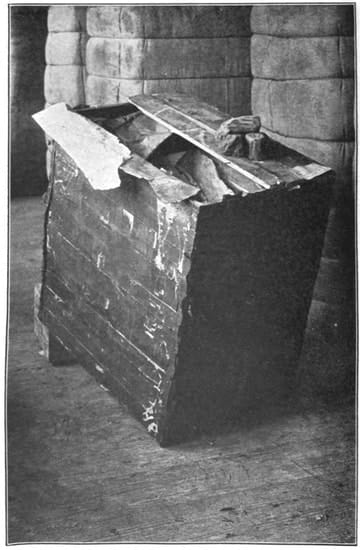 Rhubarb as exported 100 years ago. Wooden case with
Rhubarb as exported 100 years ago. Wooden case withyellow tissue paper lining a hermetically sealed inner tin.
Squibb’s Atlas of the Official Drugs, Mansfield, 1919
-
More Info
- History
-
Research
|
‘The Chinese appear to have been acquainted with the properties of rhubarb from a period long anterior to the Christian era, for the drug is treated of in the herbal called Pen-king, which is attributed to the Emperor Shen-nung, the father of Chinese agriculture and medicine, who reigned about 2700 B.C. The drug is named there Huang-Hang, yellow excellent, and Ta-huang, the great yellow. The latter name also occurs in the great Geography of China, where it is stated that rhubarb was a tribute of the province Si-ning-fu, east ward of Lake Kuku Nor, from about the 7th to the 10th centuries of our era. As regards Western Asia and Europe, we find a root called [?] or [?], mentioned by Dioscorides as brought from beyond the Bosphorus. The same drug is alluded to in the fourth century by Ammianus Marcellinus, who states that it takes its name from the river Rha (the modern Volga), on whose banks it grows. Pliny describes a root termed Bhacoma, which when pounded yielded a colour like that of wine but inclining to saffron, and was brought from beyond Pontus. The drug thus described is usually regarded as rhubarb, or at least as the root of some species of Rheum, but whether produced in the regions of the Euxine (Pontus), or merely received thence from remoter countries, is a question that cannot be solved. It is however certain that the name Radix pontica or Rhaponticum, used by Scribonius Largus and Celsus, was applied in allusion to the region whence the drug was received. Lassen has shown that trading caravans from Shensi in Northern China arrived at Bokhara as early as the year 114 B.C. Goods thus transported might reach Europe either by way of the Black Sea, or by conveyance down the Indus to the ancient port of Barbarike. Vincent suggests that the rha imported by the first route would naturally be termed rha-ponticum, while that brought by the second might be called rha-barbamm. We are not prepared to accept this plausible hypothesis. It receives no support from the author of the Periplus of the Erythrean Sea (circa a.d. 64), whose list of the exports of Barbarike does not include rhubarb; nor is rhubarb named among the articles on which duty was levied at the Roman custom-house of Alexandria (A.D. 176-180). The terms Rheum barbarum vel barbaricum or Reu barbarum occur in the writings of Alexander Trallianus about the middle of the 6th century, and in those of Benedictus Crispus, archbishop of Milan, and Isidore of Seville, who both flourished in the 7th century. Among the Arabian writers on medicine, the younger Mesue, in the early part of the 11th century, mentions the rhubarb of China as superior to the Barbaric or Turkish. Constantinus Africanus about the same period speaks of Indian and Pontic Rheum, the former of which he declares to be preferable. In 1154 the celebrated Arabian geographer Edrisis mentions rhubarb as a product of China, growing in the mountains of Buthink— probably the environs of north-eastern Tibet near Lake Tengri Nor (or Bathang in Western Szechuen ?). Rhubarb in the 12th century was probably imported from India, as we may infer from the tariff of duties levied at the port of Aeonin Syria, in which document it is enumerated along with many Indian drugs. A similar list of A.D. 1271, relating to Barcelona, mentions Ruibarbo. In a statute of the city of Pisa called the Breve Fundticariorum, dating 1305, rhubarb (ribarbari) is classified with commodities of the Levant and India. The first and almost the only European who has visited the rhubarb-yielding countries of China is the famous Venetian traveller, Marco Polo, who speaking of the province of Tangut says— ” … et par toutes les montagnes de ces provinces se treuve le reobarbe en grant habondance. Et illec l’achatent les marchans et le portent par le monde.” A sketch of the history of rhubarb would be incomplete without some reference to the various routes by which the drug has been conveyed to Europe from the western provinces of the Chinese Empire, and which have given rise to the familiar designations of Russian, Turkey and China Rhubarb. The first route is that over the barren steppes of Central Asia by Yarkand, Kashgar, Turkestan, and the Caspian to Russia; the second by the Indus or the Persian Gulf to the Red Sea and Alexandria, or by Persia to Syria and Asia Minor; and the third by way of Canton, the only port of the Chinese Empire which, previous to the year 1842, held direct communication with Europe. In 1653 China first permitted Russia to trade on her actual frontiers. The traffic in Chinese goods was thereupon diverted from the line of the Caspian and Black Sea further north, taking its way from Tangut across the steppes of the high Gobi, and through Siberia by Tobolsk to Moscow. Thus it is mentioned in 1719 that Urga on the north edge of the Gobi desert was the principal depot for rhubarb. From the earliest times, Bucharian merchants appear to have been agents on this traffic, the producers of the drug never concerning themselves about its export. Consequent on the rectification of frontier in 1728, a line of custom houses was established by treaty between Russia and China, whereby the commerce, |
previously unrestricted, was limited to the government caravans which passed the frontier only at Kiachta and at Zuruchaitu, south of Nerchinsk. The latter place always remained unimportant, while Kiachta and the opposite Chinese town of Maimatchin became the staple depots of rhubarb. The root was subjected to special control as early as 1687-1697 by the Russian Government, who finally monopolized the trade about 1704. Caravans fitted out by the Crown alone brought the drug to Moscow, until 1762, when the caravan-trade was for a while thrown open. It was not until this period that the export of rhubarb became consider able, although the stringent regulations, established in 1736, were still maintained. The surveillance of rhubarb was exercised at Kiachtaina special court or office called the Brake, under instructions from the Russian Minister of War, by an apothecary appointed for six years, the object being to remove from the rhubarb brought for inspection all interior or spurious pieces, and to improve the selected drug by trimming, paring and boring. It was then carefully dried, and packed in chests, which were sown up in linen, and rendered impervious to wet by being pitched and then covered with hide. The drug was dis patched, but only in quantities of 1000 puds (-10,000 lb.), once a year by way of Lake Baikal and Irkutsk to Moscow, whence it was transmitted to St. Petersburg, to be there delivered to the Crown apothecaries and in part to be sold to druggists. We are indebted for these accounts chiefly to Calau, an apothecary appointed to supervise the examination of rhubarb, and who resided a long time at Kiachta. An exact account of the remarkable policy of the Russian Government in relation to that drug was also given by Von Schrbders in 1864. So long as China kept all her ports closed to foreign commerce except Canton in the extreme south, a large supply of fine rhubarb found its way to Europe by way of Russia. But the unpleasant accompaniments of the Russian supervision, which was exercised with unsparing severity, and the extreme tediousness of the land-transport, made the Chinese very ready to accept an easier outlet for their goods. Accordingly we find that the opening of a number of ports in the north of China exerted a very depressing influence on the trade of Kiachta, which was augmented by the rebellion that raged in the interior of China for some years from 1852. On these accounts Russia in 1855 removed certain restrictions on the trade, though without abandoning the Rhubarb Office. She with drew in 1860 the custom-house to Irkutsk, and declared Kiachta a free port, while by the treaty with China of November 1800, she insisted on that country abandoning all restrictions on trade. But the over-land rhubarb trade had already been destroyed: the Chinese, tempted by the increased demand occasioned by the new trading-ports, became less careful in the collection and curing of the root, while the Russians insisted with the greatest strictness on the drug being of the accustomed quality. Hence it happened that from 1860 hardly any rhubarb was delivered at Kiachta, either for the government use or to private traders; and in 1868 the Rhubarb Office was abolished. Thus the so-called Russian or Muscovitic or Crown Rhubarb, familiarly known in England as Turkey Rhubarb, a drug which for its uniformly good quality long enjoyed the highest reputation, has become a thing of the past, which can only now be found in museum collections. It began to appear in English commerce at the commencement of the last century. Alston, who lectured on botany and materia medica at Edinburgh in 1720, speaks of rhubarb as brought from Turkey and the East Indies,— ” and of late, likewise from Muscovy.” It has been shown that rhubarb was shipped from Syria in the 12th century. Vasco da Gama mentions it in 1497 among the exports of Alexandria. In fact, the drug was carried from the far east to Persia, whence it was brought by caravans to Aleppo, Tripoli, Alexandria, and even to Smyrna. From these Levant ports it reached Europe, and was distributed as Turkey Rhubarb; while that which was shipped direct from China, or by way of India, became known as China, Canton, or East India Rhubarb. The latter was already the more common sort in England as early as 1640. As the rhubarb of the Levant disappeared from trade, that of Russia took not only its place but likewise its name, until the term “Turkey Rhubarb” came to be the accepted designation of the drug imported from Russia. This strange confusion of terms was not however prevalent on the Continent, but was chiefly limited to British trade. The risk and expense of the enormous land-transport over almost the whole breadth of Asia, caused rhubarb in ancient times to be one of the very costly drugs. Thus at Alexandria in 1497, it was valued at twelve times the price of benzoin. In France in 1542, it was worth ten times as much as cinnamon, or more than four times the price of saffron. At Ulm in 1596, it was more costly than opium. A German price-list of the magistrate of Schweinfurt, of 1614, shows Radix Rha Barbari to be six times as dear as fine myrrh, and more than twice the price of opium. An official English list giving the price of drugs in 1657, quotes opium as 6s. per lb., scammony 12s., and rhubarb 16s.’ (Pharmacographia, Fluckiger & Hanbury, 1879) |
